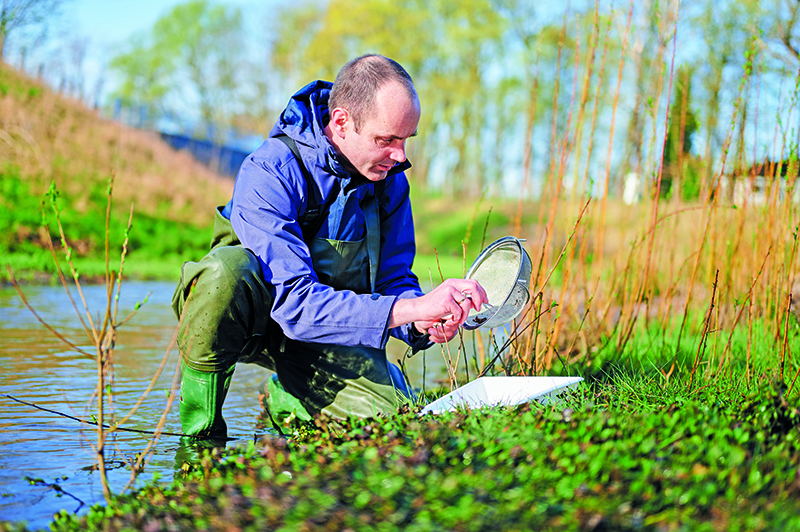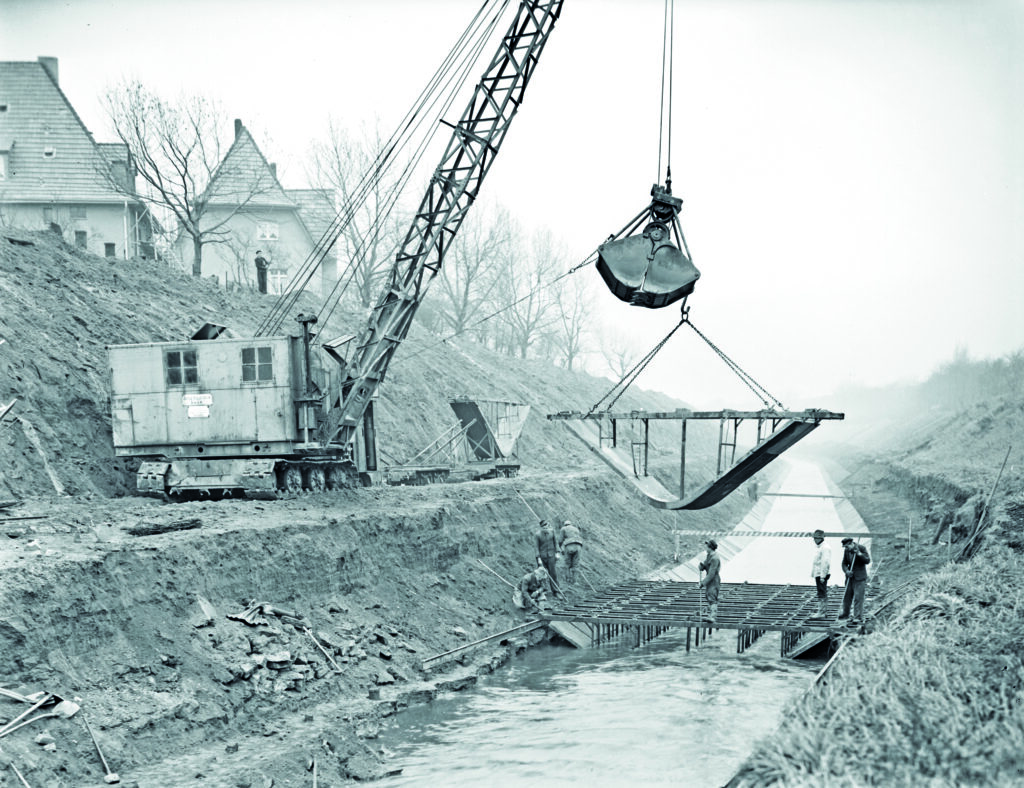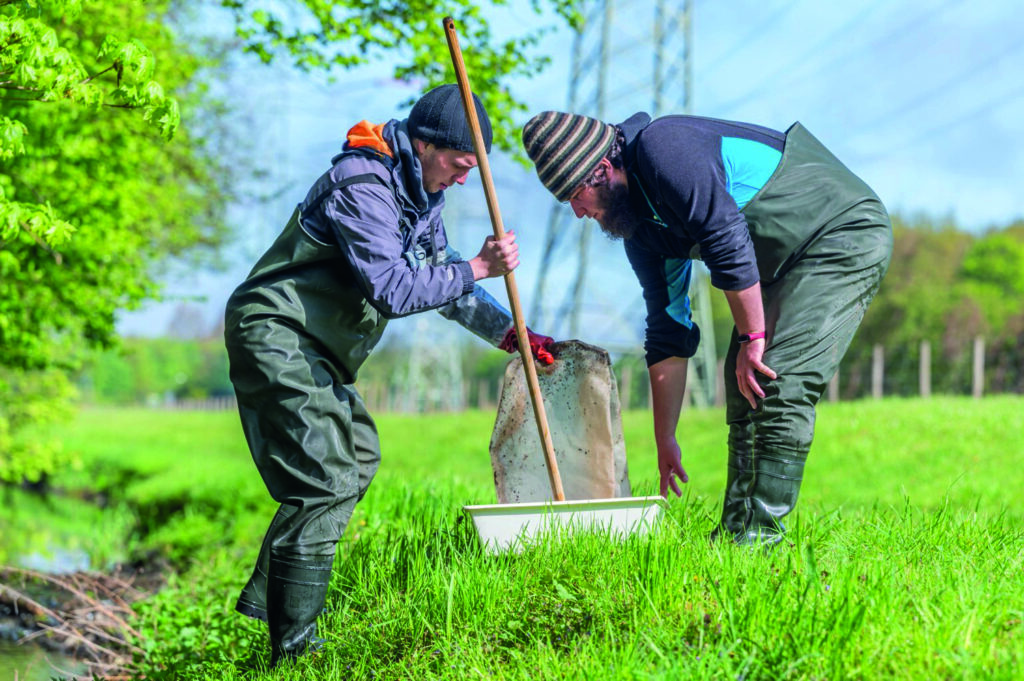Most Expensive River In The World
The Emscher was once dead, but now it has undergone a miraculous transformation. In high-profile projects UDE’s researchers are investigating how its ecosystem is recovering and how it can serve as a model worldwide. By Jennifer Meina
The water is not crystal clear – here in Gladbeck, where Haarbach creek meets the 13 kilometre-long river Boye. The second-longest tributary of the Emscher seems a bit murky, even on this sunny morning. Nevertheless, again and again one sees tiny critters gliding elegantly along the rubber boots of Dr. Daniel Grabner. The chirping and rustling from the banks, between grasses and stones in the muddy soil, suggests that there are many more inhabitants here. And the people, too, who are spending time here on their bicycle or with their dog, are obviously enjoying the natural surroundings. Life has returned to the Emscher and its tributaries. So is it indeed a little green oasis?
Not quite yet. After all, not even a year has passed since the ecological restoration of the water body and its bank was completed here. And yet: ‘The current state was long completely unimaginable,’ explains Daniel Grabner. The biologist is also scientific coordinator of the Collaborative Research Centre RESIST. He and his team are currently checking up on the central field experiment of the project: a large two-storey installation whose core elements are innumerable hoses, vats, basins and a whole lot of water. The structure is part of the ExStream project, headed by UDE researcher Prof. Dr. Florian Leese (aquatic ecosystem research). This is where numerous RESIST subprojects obtain the samples they need. The central aim of the researchers is to find out how water bodies and their biotopes respond to the many man-made stressors on the river – and how a path back to the natural river can work. International experts are also eagerly awaiting the findings.
Grabner takes a deep breath. It smells neutral – quite the opposite of what people smelled in the same place just a few decades ago. ‘Shit creek,’ ‘latrine,’ ‘trough pisser’ – the names residents gave to their Emscher – which, with a length of around 83 kilometres, winds its way around almost the entire Ruhr region – were by no means flattering. But what the water body and its tributaries had to absorb was not flattering either.

Waste water solution
A look back – at the end of the nineteenth century. The Ruhr region is in the middle of industrialisation. Steel and coal are important drivers of the economy; people come in droves to live and work in the coalfields. But where to put the waste water? Underground canals are not an option, because the underground work repeatedly causes the earth to sink. So the waste water must be discharged on the surface. Into the river? But it regularly overflows the bank. The sewage floods the cities – also leading to the spread of diseases like typhus or cholera. The only solution is to convert the Emscher into a waste water canal, meaning that it also needs to be straightened with concrete troughs. From 1899 on, faeces from households as well as toxic chemicals from industry flowed officially into the once nearly unspoilt watercourse – right in the middle of Germany. ‘There was practically no life left in the water apart from some bacteria,’ says Grabner.
‘With MERLIN, our aim is to make a contribution to a more sustainable use of our water bodies in the future’

Up until a good 30 years ago. In 1991, the Emschergenossenschaft decided together with its members – municipalities, industry, commerce and mining – and the state of North Rhine-Westphalia to redevelop the Emscher into a healthy water system. There were no role models for a project at this scale. Pioneering work was required for the Emschergenossenschaft, which was responsible for both the planning and the implementation – and successfully so. The Emscher conversion is a model project and makes the little watercourse into the most expensive river in the world. Three decades and around 5.5 billion euros later, the project is largely completed – the river and nearly all of its 35 tributaries are again free of waste water as of the end of 2021. A milestone not just for the people. The amount of indigenous species has tripled in the past 20 years.
RESIST
RESIST is a Collaborative Research Centre funded by the German Research Foundation (DFG) and is coordinated by Prof. Dr. Bernd Sures and Dr. Daniel Grabner. The project is receiving 12.3 million euros in the first (of a possible three) funding periods (2021 to 2024). Also participating besides the UDE are teams from the Universities of Bochum, Cologne, Kiel and Koblenz-Landau, as well as the Institute of Freshwater Ecology and Inland Fisheries (Berlin) and the Helmholtz Centre for Environmental Research in Halle and Leipzig. Twenty scientific subprojects are being conducted under the umbrella of RESIST with the aim of combining the individual results and generating overarching models and hypotheses.
Further information:
sfb-resist.de/
Video of Daniel Grabner at the Boye (German only):
udue.de/emscherprojekte
Open-air laboratory
Ranging from important viruses, small crustaceans, and numerous fly species to fish, the biodiversity that has returned within such a short time is already impressive, says Grabner. He is standing in his waders in the river with water up to his knees, pulling numerous river dwellers out of the water with a sieve. But even if everything has been done for an ecological restoration in theory, the river is still not as it should be from an ecological standpoint. ‘Unfortunately, it won’t be enough, if one wishes to make it look as though waste water never flowed through here, to keep out the waste water, remove the concrete lining, plan a more meandering course, make the embankments lower and more varied, move stones and dead wood.’ But why not? The team also expects the so-called mesocosm experiments to provide answers in the coming years. These plastic bowls, which are somewhat reminiscent of large gugelhupf cake moulds, recreate artificial mini-ecosystems. They are subjected to various stressors, factors that negatively affect organisms.

Grabner points at the long hoses that lead up to the installation from the Boye. ‘We direct the river water into the 64 bowls, where we have previously introduced organisms. Now we introduce sand or warm water as desired and also change the flow rate. Subsequently, we investigate the effects of such stressors on the organisms in the laboratory.’ These reconstructed scenarios are typical environmental burdens like those caused by humans: such as by conventional agriculture, global warming, overflowed mine water or discharged cooling water from industry and hydroelectric plants that change the speed of the current.
The scientists are studying how the three stressors take effect individually as well as together at various levels: They look at the food web or ecosystem functions, such as decomposition of fallen leaves and nutrient cycles. The Boye provides outstanding conditions for these experiments: ‘There are several areas that have undergone little structural transformation but many that have been significantly altered and are now restored – some of them long ago, others only recently. We can compare any number of sites with different characteristics here and see the different developments in the ecological restoration of water bodies.’ That is particularly interesting for a further RESIST subproject, in which the researchers take samples of organisms in the individual stretches of the Boye each year to ascertain differences between the various restored sites.
Another central point of the research, which will run until at least 2024, involves developing models to predict what happens when
a river is restored in a particular way. The Emscher is to become a model for rivers throughout Europe – and this is precisely where the second major water project being conducted at the UDE comes in: MERLIN.

Perfect interplay
Change of location. We are now several kilometres downstream. This is the site of the new Emscher floodplain at Holtener Bruch
in Oberhausen – or at least it will be. Today, the Emscher is still a narrow canal here. Soon it will receive space to grow and become a real river again – including a floodplain landscape. It will be populated by birds as well as insects, reptiles and amphibians. It will also become an important place for flood protection, because although the river will clearly overflow its banks here during heavy rainfall, the meadow will absorb the water, therefore preventing flooding in other places. Wetlands can store carbon dioxide in the soil, and green ecosystems also provide local recreation areas, which are valued by people in both densely populated and agricultural regions. ‘It will be a perfect interplay between nature’s needs and human interests,’ explains Dr. Sebastian Birk. He is also an aquatic ecologist at the UDE – and coordinator of the EU-funded project.
MERLIN was launched in October 2021 and will run until at least September 2025. The scientists and their partners from all over Europe have a lot to do in these four years. They will be evaluating 17 case studies from Finland to Israel. And as different as they are – ranging from beaver dams in Scandinavia and peatlands in Scotland to Danube floodplains in Romania – they are united by a common goal: increasing the acceptance of ecological restoration projects in society, but above all also in business and politics. After all, ecological restoration is not at the top of everyone’s agenda – or even on it at all. And besides, there are clear differences: In Western Europe projects in this area are usually initiated and funded by the state or official bodies, while in Eastern Europe they are almost exclusively in the hands of non-governmental organisations like the environmental organisation WWF.

MERLIN
The MERLIN project, which is receiving 21 million euros in EU funding within the context of the ‘Green Deal,’ runs from October 2021 to September 2025 and is coordinated by Prof. Dr. Daniel Hering and Dr. Sebastian Birk. It includes 45 partners from across Europe, including universities, research institutes, environmental organisations, water boards, and representatives from business, administration, and municipalities. Half of the project funds go to concrete ecological restoration projects for the 17 case studies.
Further information:
project-merlin.eu
Pan-European problems
‘With MERLIN, our aim is to make a contribution to a more sustainable use of our water bodies in the future,’ says Birk. The plan is to demonstrate by way of good models that ecological restoration is not only important for plants and animals but also for our prosperity, our health and social peace. After all, the problems are similar all over Europe: flood disasters threaten human life or destroy the infrastructure – causing immeasurable suffering to those affected and costing insurance companies millions. Drought events create water scarcity and lead to drinking water shortages and large-scale crop losses.
What this means for the Emscher is that MERLIN will further improve the environment along its banks. Flowering meadows in particular are to be laid out and sustainably used. This requires an efficient cultivation and use of the cuttings. ‘The Emscher conversion is a leading global example of successful ecological restoration – and one with the most difficult starting conditions,’ says Birk. So if it is possible to bring even the once dead Emscher back to life, should it not be possible to do that everywhere? Yes, that is the idea.
The diverse case studies are only the beginning but form an important basis: MERLIN pools extensive knowledge on restoration from the regions in Europe in which streams, rivers, floodplains, peatlands and wetlands are being brought back to a near-natural state. This sheds light on problems as well as ways to solve them and make them transferable.
Nature-based solutions
Birk sums up his task in three questions: (1) How does restoration have to be implemented in concrete terms in order to be successful under the respective circumstances, (2) what social and financial conditions are conducive to this implementation and (3) how can relevant decision-makers in business, society and politics be won over for ecological restoration? ‘Restorations do not just bring back the dragonflies; they also serve many other functions. We want to make that visible.’
The past has shown what does not work: It is not enough to make long-winded assertions that ‘we’ will be better off afterwards, when nature is better off. ‘MERLIN makes a wide array of concrete suggestions on how nature-based solutions make cities and landscapes more attractive and how they make economic sense.’
Treading new paths also means reassessing the old ones. The aims of the EU Water Framework Directive were supposed to be achieved by 2015. Now the deadline has been extended to 2027. ‘But even by then they probably won’t be achieved, simply because they collide with other interests, such as those of agriculture.’ What one needs to make a change is knowledge – and MERLIN is doing that. There has already been a good exchange with various associations of water suppliers, insurers and the transport shipping industry. ‘The only way to make it work is by talking to one another and passing on knowledge.’



